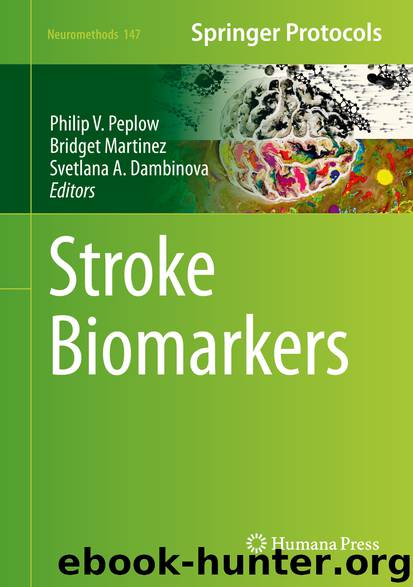Stroke Biomarkers by Unknown

Author:Unknown
Language: eng
Format: epub
ISBN: 9781493996827
Publisher: Springer New York
7.5 Data Analysis Plan
Initial analyses will include basic frequency of each peptide values in control groups of healthy volunteers, subjects with preexisting conditions and stroke mimics. The examination of the influence of demographic factors on baseline GluR peptides (gender, race, age, etc.; likely through t test, ANOVA, or Pearson correlation depending on the nature of the demographic factors) will be examined.
There are expected some nonparametric analyses (likely chi-square) examining basic frequencies of GluR peptides (elevated/not-elevated) for subjects with preexisting conditions or stroke mimics vs. healthy volunteers, frequencies of GluR peptides levels (elevated/not-elevated) in all control groups vs. hemorrhagic stroke, frequencies of GluR peptides levels (elevated/not-elevated) in all control groups vs. ischemic stroke, and frequencies of GluR peptides amounts (elevated/not-elevated) in stroke (hemorrhagic and ischemic) and MRI findings (abnormal/normal).
Then each peptide (NR2, AMPAR, and KAR) critical cutoffs at 0–6 and 6–12 h after the onset to diagnose ischemic cerebral events will be established. In the first phase, a receiver operating characteristics (ROC) curve (sensitivity vs. specificity) for corresponding time window by varying the cutoff value for distinguishing IS from non-ischemic events will be constructed. The final diagnosis of acute ischemic stroke is based on MRI data as a gold standard.
The partial area under the ROC curve for the region with specificity between 0.75 and 0.95, denoted by area under the curve () as a global measure of the diagnostic effectiveness of each peptide will be used. It is considered that the partial area rather than the commonly used total AUC is of clinical interest since only the region with high specificity. The standardized partial area can be interpreted as the average sensitivity level when the specificity level lies within the range [0.75, 0.95]. To test the global null hypothesis that the GluR peptide does not have adequate accuracy at any of the time windows, we will evaluate whether the average across the time windows is at least 0.8.
At the end of the first phase, the empirical estimate for the ROC curve is constructed and its standard errors should be estimated [65]. Moreover, we will use the perturbation technique to construct the confidence band for the ROC curve see [66]. If the confidence intervals or band for the estimated ROC curves are not tight enough for n = 100 per time window, then it will need additional participants enrolled in the first phase to improve the precision. Since the adjustment is only made considering the sampling variability and is not for time window comparisons, no statistical adjustment for type I error is necessary even if the sample size is increased.
After approximately half of the target participants are enrolled, a futility analysis by calculating the conditional power for testing the null hypothesis that across the 2-time windows is less than or equal to 0.8 versus the alternative hypothesis that it is at least 0.8 should be conducted. This conditional power is the probability of rejecting the null hypothesis at the end of this first phase, given the data at the halfway point.
As soon
Download
This site does not store any files on its server. We only index and link to content provided by other sites. Please contact the content providers to delete copyright contents if any and email us, we'll remove relevant links or contents immediately.
| Automotive | Engineering |
| Transportation |
Whiskies Galore by Ian Buxton(41885)
Introduction to Aircraft Design (Cambridge Aerospace Series) by John P. Fielding(33064)
Small Unmanned Fixed-wing Aircraft Design by Andrew J. Keane Andras Sobester James P. Scanlan & András Sóbester & James P. Scanlan(32744)
Craft Beer for the Homebrewer by Michael Agnew(18146)
Turbulence by E. J. Noyes(7942)
The Complete Stick Figure Physics Tutorials by Allen Sarah(7312)
Kaplan MCAT General Chemistry Review by Kaplan(6868)
The Thirst by Nesbo Jo(6832)
Bad Blood by John Carreyrou(6558)
Modelling of Convective Heat and Mass Transfer in Rotating Flows by Igor V. Shevchuk(6392)
Learning SQL by Alan Beaulieu(6213)
Weapons of Math Destruction by Cathy O'Neil(6152)
Man-made Catastrophes and Risk Information Concealment by Dmitry Chernov & Didier Sornette(5926)
Digital Minimalism by Cal Newport;(5669)
Life 3.0: Being Human in the Age of Artificial Intelligence by Tegmark Max(5479)
iGen by Jean M. Twenge(5368)
Secrets of Antigravity Propulsion: Tesla, UFOs, and Classified Aerospace Technology by Ph.D. Paul A. Laviolette(5311)
Design of Trajectory Optimization Approach for Space Maneuver Vehicle Skip Entry Problems by Runqi Chai & Al Savvaris & Antonios Tsourdos & Senchun Chai(5012)
Pale Blue Dot by Carl Sagan(4917)
